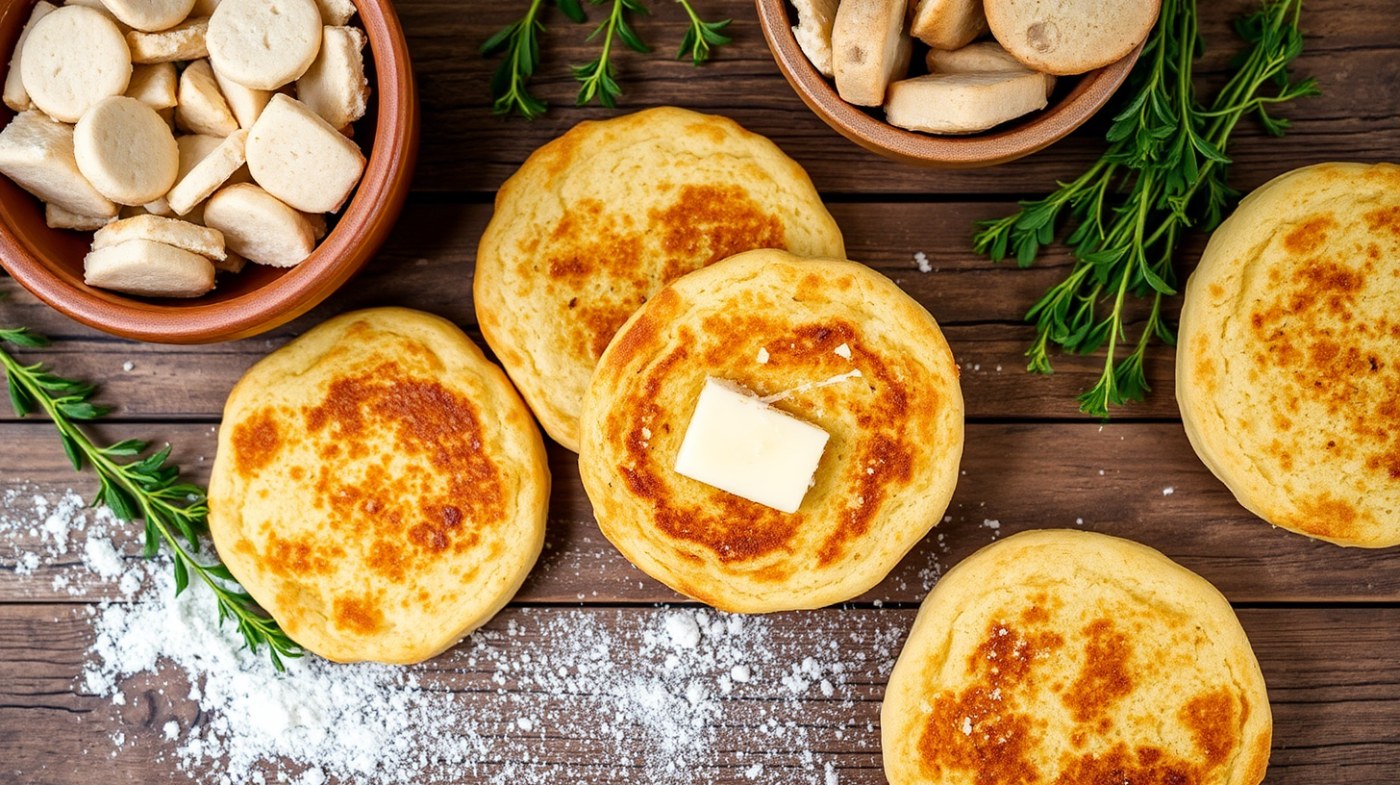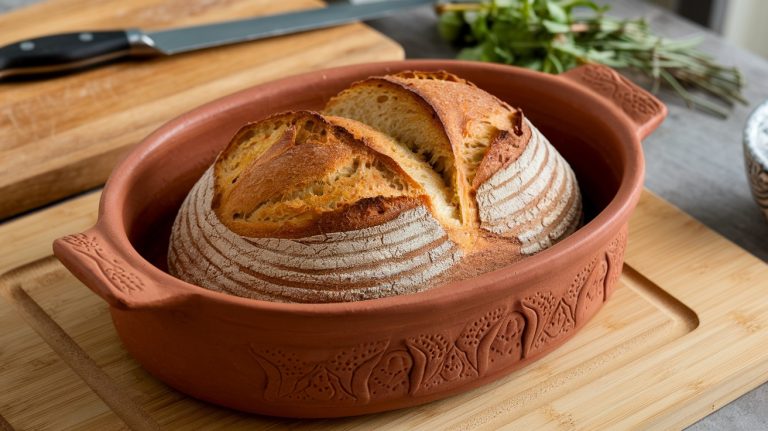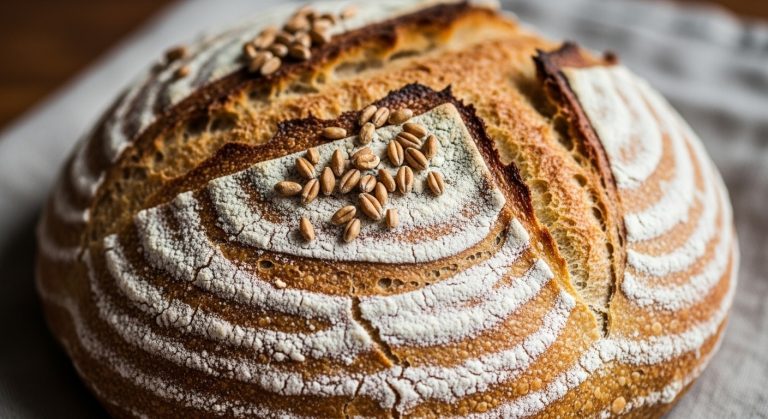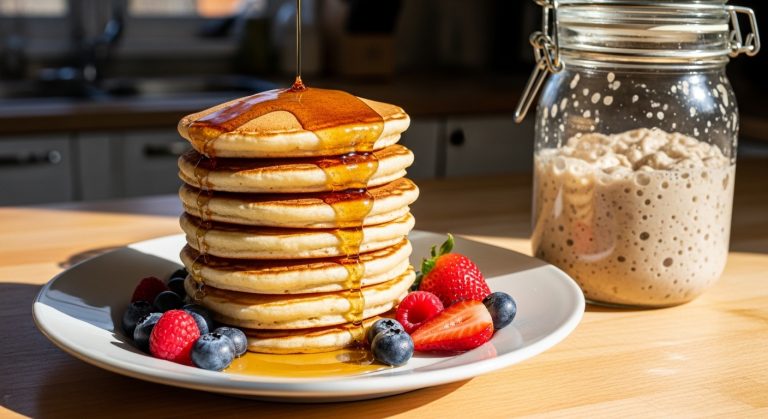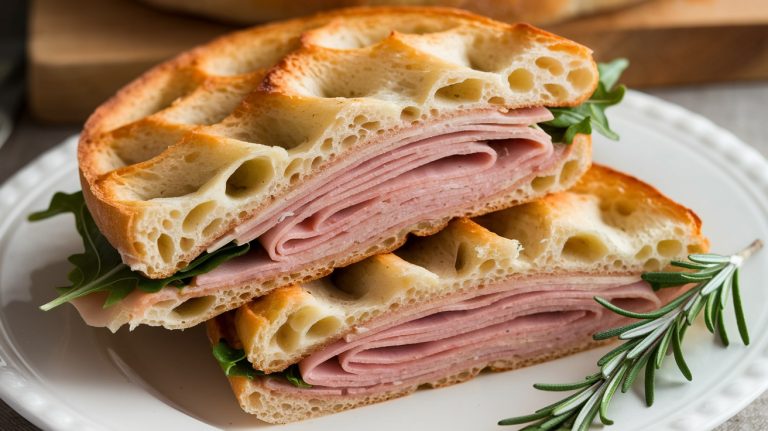Sourdough Discard English Muffin: Leftover Breakfast Delight
Using sourdough discard to make English muffins is a fantastic way to reduce waste while enjoying a tasty breakfast. Mix unfed sourdough starter with flour and buttermilk, allowing the dough to rest overnight for maximum flavor.
Once you’re ready, roll out and cut the dough into rounds. Cooking them in a skillet gives you that perfect crunchy exterior with a soft inside.
Feel free to add your favorite spices or cheese for a unique twist! These muffins are delicious and can be stored or frozen for later. There’s so much more to discover about this delightful treat.
Key Takeaways
- Sourdough discard enhances the flavor of English muffins while reducing kitchen waste, making it a sustainable baking option.
- The recipe requires simple ingredients like unfed sourdough discard, all-purpose flour, buttermilk, and baking soda.
- Allow the dough to rest overnight for fermentation, improving flavor and texture before shaping and cooking.
- Cook muffins in a preheated skillet at 300°F for about 5 minutes on each side until golden brown.
- Store cooled muffins in an airtight container for up to 5 days or freeze for up to 3 months, preserving their texture.
Ingredients and Substitutions
Creating the perfect Sourdough Discard English Muffins starts with gathering the right ingredients, each crucial to achieving that delightful balance of flavor and texture.
You’ll want to use unfed sourdough discard as a base, which not only contributes to the unique flavor profile but also reduces food waste by utilizing leftover starter.
Combining it with the following key ingredients:
- Flour: All-purpose flour is your go-to, but you can opt for whole wheat flour for a healthier twist. Just remember, it may need a bit more liquid due to its density.
- Liquid: Buttermilk brings moisture and a tangy flavor, but if you don’t have it, water will work just fine.
- Leavening agents: Baking soda is essential, but if you’re using an older sourdough discard, consider swapping it out for instant yeast for better rising.
Don’t forget salt to enhance the flavors and a touch of sugar for sweetness.
For dusting, cornmeal does a great job, but if you’re out, semolina flour makes an excellent alternative to prevent sticking.
By carefully selecting your ingredients and making these substitutions, you’ll set the stage for wonderfully fluffy English muffins that are bursting with flavor!
If you want to explore more creative uses for sourdough discard, check out the ideas for enhancing your baked goods with flavor enhancements.
Dough Preparation
To kick off your dough preparation, you’ll start by mixing unfed sourdough discard, filtered water, and all-purpose flour, allowing it to sit overnight for maximum flavor.
This fermentation process not only enhances the taste but also contributes to the gut health benefits of sourdough.
The next morning, you’ll add more flour, salt, baking soda, and sugar, ensuring everything comes together nicely.
After a short rest, your dough will be ready for rolling and cutting, setting the stage for those delicious, homemade English muffins.
Mixing Ingredients
Often, the key to a perfect sourdough discard English muffin lies in how you mix the ingredients together. Start by creating a wet mixture that forms the base of the dough. Combine 1 cup of unfed sourdough discard with 1 cup of filtered water in a mixing bowl.
As you gradually add 2 cups of all-purpose flour, mix until the dough begins to pull away from the sides of the bowl and becomes cohesive. To achieve a flavorful and crusty muffin, it’s crucial to use a well-fed sourdough starter, as its importance notably impacts the dough’s rise and texture. For more insights on maintaining your starter, check out sourdough starter readiness.
Here are three essential ingredients to incorporate for peak flavor and rise:
- Salt: Add 1 teaspoon for seasoning.
- Baking Soda: Include 1 teaspoon to aid in leavening.
- Sugar: Mix in 1 tablespoon to enhance the dough’s sweetness.
Once you’ve mixed these ingredients, guarantee even distribution for the best results. Cover the bowl and let the dough rest for about 30 minutes; this relaxes the gluten and improves texture.
After resting, roll the dough out to a thickness of 1/2 inch. Finally, use a round cutter to shape it into individual muffins, ready for frying.
Kneading The Dough
After you’ve mixed your ingredients together, kneading the dough becomes your next focus. This step is essential for developing gluten, which gives your sourdough English muffins that desired light and airy texture. Aim to knead the dough for about 5 minutes. You’ll know it’s ready when it turns smooth and elastic, indicating sufficient gluten development.
If you’re using a stand mixer, keep it on low speed to prevent overworking the dough, which can lead to dense muffins. As you knead, if the dough feels too sticky, incorporate flour gradually, especially if you’re working with high hydration levels that can complicate handling. This keeps the dough moist but manageable, allowing you to work it effectively.
Once you’ve achieved that perfect consistency, don’t skip the resting phase. Allow the dough to rest for 30-60 minutes after kneading. This vital step helps relax the gluten, leading to an improved overall texture in your muffins.
Rising Process
The rising process is where your sourdough discard English muffins begin to transform, creating that delightful texture and flavor you crave. This vital stage sets the foundation for your muffins, allowing them to rise and develop the perfect light and airy quality.
- Overnight Resting Period: Combine your sourdough discard with water and flour, then let it sit overnight. This fermentation period develops incredible flavor and texture.
- Mixing and Gluten Development: After resting, mix in additional flour, salt, baking soda, and sugar. Allow the dough to rest for 30 minutes to enhance gluten development — this is essential for that chewy, puffy texture.
- Final Rise in a Warm Environment: Shape your dough into rounds and let them rise for 45-60 minutes in a warm environment. This helps the dough increase in size, so look for those visual cues of puffy, light, and airy muffins.
Cooking Process
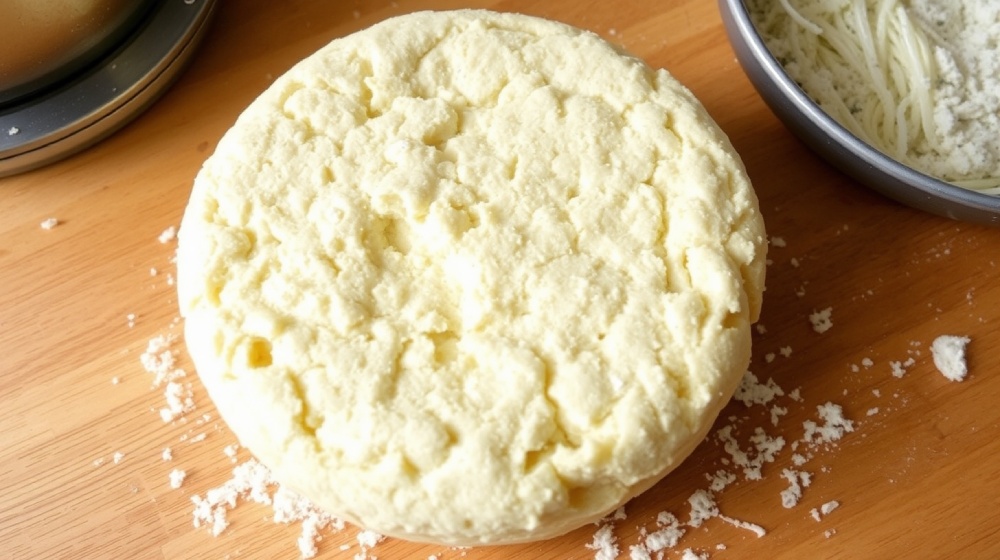
Once you’ve shaped the muffins, place them on a cornmeal or semolina-lined baking pan and let them rise for 1-2 hours; you’ll notice they become puffy and nearly double in size.
This rising process is essential for achieving light, airy muffins. Once they’re ready, it’s time to cook! Preheat a skillet to 300°F (150°C) and gently cook the muffins covered for 5 minutes on each side.
You’re aiming for that golden brown color and an internal temperature between 195-200°F (90-93°C). If your muffins are thicker, don’t hesitate to finish them in a preheated oven at 350°F (175°C) for an extra 10 minutes, ensuring they’re fully cooked.
During cooking, remember to flip the muffins several times; this promotes even heat distribution and helps achieve that perfect texture without getting too dense or overcooked.
Once they’re done, resist the urge to slice them with a knife. Instead, use a fork to split them, which will give you those signature craggy edges that are perfect for holding your favorite toppings.
Storage and Freezing
Properly storing your freshly made sourdough discard English muffins guarantees you can enjoy their delightful taste for days to come.
When you freeze your muffins, you not only enhance their flavor, but they also keep their texture.
Here’s how to keep them fresh and flavorful:
- Airtight Container: Once your muffins are completely cooled, store them in an airtight container at room temperature. This keeps them fresh for up to 5 days without losing that delightful texture.
- Freezing for Longevity: For longer storage, consider freezing your muffins. Split them before placing them in a freezer-safe bag or container; this makes for easy toasting later on. You can freeze them for up to 3 months without sacrificing flavor.
- Reheating Tips: When you’re ready to enjoy a muffin, simply toast it directly from the freezer. This method preserves the texture and enhances the flavor, giving you that freshly-baked experience.
Tips for Success
Baking the perfect sourdough English muffin requires a few key techniques to achieve that ideal texture and flavor. First, verify your sourdough starter is active and bubbly; this is essential for proper fermentation and rise in your muffins.
After mixing your ingredients, let the dough rest for at least 30 minutes to enhance gluten development, which improves the texture.
Preheat your skillet and set it to low heat when it’s time to cook. This allows for a more even cooking process. Cover and cook the muffins for about 5 minutes per side, trapping steam to create that soft interior.
To check for doneness, use a thermometer; aim for an internal temperature of 195-200°F.
Once they’re cooked, allow the muffins to cool slightly before handling. When you’re ready to enjoy them, split them with a fork instead of a knife. This technique creates those signature nooks and crannies that hold toppings beautifully.
Frequently Asked Questions
Can I Use Whole Wheat Flour Instead of All-Purpose Flour?
You can definitely use whole wheat flour instead of all-purpose flour! Just remember, it’ll create denser textures and a nuttier flavor. Adjust hydration slightly, and enjoy experimenting with this wholesome alternative in your baking.
How Long Can I Keep Sourdough Discard Before Using It?
You can keep sourdough discard in the fridge for about a week. If you want it fresh longer, consider freezing it. Just remember to feed it regularly to maintain its lively fermentation for baking!
What Can I Substitute for the Butter in the Recipe?
You can substitute butter with coconut oil, olive oil, or applesauce for a healthier twist. Each option adds unique flavors while keeping your recipe moist. Just remember to adjust measurements for the best results.
Can I Add Toppings Like Cheese or Herbs to the Dough?
You can mix in cheese or herbs directly into the dough. Imagine the aroma wafting through your kitchen as they bake, creating a deliciously savory treat that elevates your culinary creation to new heights.
Is It Possible to Make These Muffins Gluten-Free?
Absolutely, you can make gluten-free muffins! Just substitute gluten-free flour blends for regular flour and adjust the liquid as needed. Experimenting with different flours can lead to delicious, fluffy results you’ll love. Enjoy baking!
Leftovers Can Shine, Too!
In the world of baking, “waste not, want not” rings true, especially with sourdough discard. You’ve transformed what could’ve been tossed into delicious English muffins, bursting with flavor and texture.
By embracing this approach, you’re not just minimizing waste; you’re creating something truly special. So, keep experimenting and savoring the fruits of your labor.
Each muffin is a demonstration of your creativity and resourcefulness—proof that even leftovers can rise to greatness.

